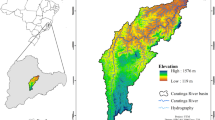Abstract
Soil erosion and contamination are two main desertification indices or land degradation agents in agricultural areas. Global climate change consequence is a priority to predict global environmental change impacts on these degradation risks. This agro-ecological approach can be especially useful when formulating soil specific agricultural practices based on the spatial variability of soils and related resources to reverse environmental degradation. Raizal and Pantanal models within the new MicroLEIS framework, the Ero&Con package, are database/expert system evaluation approach for assessing limitations to land use, or vulnerability of the land to specified agricultural degradation risks. This study was performed in Souma area with approximately 4100 ha extension in the North-West of Iran (west Azarbaijan). Based on 35 sampling soils, Typic Xerofluvents, Typic Calcixerepts, Fluventic Haploxerepts and Fluventic Endaquepts were classified as main subgroups. Climatological data, referred to temperature and precipitation of more than 36 consecutive years were collected from Urmieh station reports and stored in monthly Climate Database CDBm, as a major component of MicroLEIS DSS (CDBm) program. Climate data for a hypothetical future scenario were collected from the Intergovernmental Panel on Climate Change (IPCC) reports for the 2080s period. The evaluation approach predicts that attainable water erosion vulnerability classes were none (V1) very low (V2) and moderately low (V4) in the total of 72%, 13% and 15% of the Souma area, respectively and they will not affected by climate change. On contrary, attainable wind erosion vulnerability classes will increase. Also, phosphorous and heavy metal contamination vulnerability risks will not differ in two compared scenarios while nitrogen and pesticides vulnerability classes will be improved.
Similar content being viewed by others
References
Christensen J., Hewitson B.C., Busuioc A., Chen A., Gao. X., Jones R., Kwon W.T., Laprise R., Magana V., Mearns L. Menenedez C., Raisaenen J., Rinke A., Kolli R.K. & Sarr A. 2007. Regional Climate Projections, in IPCC Fourth Assessment Report ‘Climate Change 2007: The Scientific Basis’, Cambridge University Press.
De la Rosa D., Mayol F., Moreno J.A., Rosales A. 1986. CDBm, Monthly Climate Database. MicroLEIS 4.1. Exploring the Agro-ecological Limits of Sustainability. IRNAS, CSIC. Sevilla, Spain.
De la Rosa D., Moreno J.A. & Garcia L.V. 1993. Expert evaluation system for assessing field vulnerability to agrochemical compounds in Mediterranean regions. J. Agric. Engineer. Res. 56: 153–164.
De la Rosa D., Crompvoets J., Mayol F. & Moreno J.A. 1996. Land vulnerability evaluation and climate change impacts in Andalucia, Spain: Soil erosion and contamination. Inter. J. Agrophys. 10: 225–238.
De la Rosa D., Moreno J.A., Mayol F. & Bonson T. 2000. Assessment of soil erosion vulnerability in western Europe and potential impact on crop productivity due to loss of soil depth using the ImpelERO model. Agr. Ecosyst. Environ. 81: 179–190.
De la Rosa D., Mayol F., Moreno F., Cabrera F., Diaz-Pereira E. & Antoine J. 2002. A multilingual soil profile database (SDBm plus) as an essential part of land resources information systems. Environ. Modeling and Software 17: 721–731.
De la Rosa D., Mayol F., Diaz-Pereira E. & Fernandez M. 2004. A land evaluation decision support system (MicroLEIS DSS) for agricultural soil protection. Environ. Modeling & Software 19: 929–942.
De la Rosa D., Diaz-Pereira E., Mayol F., Czyz E.A., Dexter A.R., Dumitru E., Enache R., Fleige H., Horn R., Rajkai K. & Simota C. 2005. Soil erosion as a function of soil type and agricultural management in a Seville province area, southern Spain. Soil Till. Res. 82: 19–28.
FAO 1984. Provisional methodology for assessment and mapping of desertification. FAO-UNEP Publications, Rome.
IPCC 2007. Climate change. Fourth assessment report, synthesis report. Topic 1, Chapter 10, Valencia, Spain.
Knutson T.R. & Tuleya R.E. 2004. Impacts of CO2 included warming on simulated hurricane intensities and precipitation: sensitivity to the choice of climate model and convective parameterization. J. Climate 17: 3477–3496.
Poesen J. 1995. Soil erosion in Mediterranean environments. In: Fantechi R. et al. (eds), Desertification: a European context. Physical and socio-economic aspects, Commission of the European Communities, EUR 15415 EN, Luxembourg.
Rubio J.L. 1995. Desertification: Evolution of a concept. In: Fantechi R. et al. (eds), Desertification: a European context. Physical and socio-economic aspects, Commission of the European Communities, EUR 15415 EN, Luxembourg.
Shahbazi F., Jafarzadeh A.A., Sarmadian F., Neyshabouri M.R., Oustan S., Anaya-Romero M., Lojo M. & De la Rosa D. 2008. Land capability evaluation and climate change impacts in semi-arid and Mediterranean areas using MicroLEIS DSS. In: III Congress of Sustainable development and climate change, Huelva, Spain, pp. 216–217.
Thorenthwaite C.W. 1948. An approach toward a rational classification of climate. Geograph. Rev. 38: 55–94.
USDA 2006. Keys to Soil Taxonomy. United State Department of Agriculture Natural Resources Conservation Service. 10th Edition. Philadelphia, Pennsylvania, USA.
Author information
Authors and Affiliations
Corresponding author
Rights and permissions
About this article
Cite this article
Shahbazi, F., Jafarzadeh, A.A. & Shahbazi, M.R. Agro-ecological field vulnerability evaluation and climate change impacts in Souma area (Iran), using MicroLEIS DSS. Biologia 64, 555–559 (2009). https://doi.org/10.2478/s11756-009-0104-9
Received:
Accepted:
Published:
Issue Date:
DOI: https://doi.org/10.2478/s11756-009-0104-9




